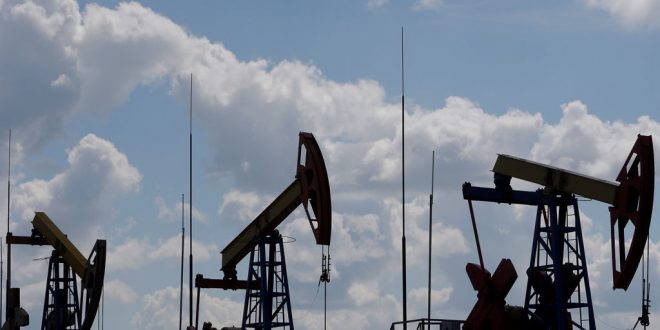World wars, depression and flu pandemics have hit oil demand before, but never has the industry faced the sudden disappearance of a fifth of its market. The suddenness and depth of the coronavirus-caused decline has gone beyond a matter of economics to one of physical reality.
As the oil business frantically juggles wells, ships and storage tanks, it has to answer very quickly: how much is demand declining, and when will it come back, if it does? How is supply going to adjust, and how much will be lost forever?
Estimates of demand decline are progressively more pessimistic, as the pandemic spreads, worsens in the US and elsewhere, and more countries impose quarantines. Vitol and Trafigura, large traders, saw global losses at 15-22 million bpd in March and April, out of about 100 million bpd global consumption previously expected for this year. Goldman Sachs estimates 18.7 million bpd down in April.
Eighty per cent of global air travel, normally using about 7.3 million barrels per day (bpd) of fuel, is shut down. Shipping, consuming some 5 million bpd, is less-affected, but demand may be down about 8 per cent currently and could fall further. Road freight has not been hit much yet, because of requirements for home deliveries, but inevitably that will drop too as people are forced to cut back to essentials. The oil industry’s use of 5 million bpd of its own products will also fall as production and refining are reduced.
US states representing 57 per cent of national gasoline demand have some kind of lockdown measure, and this will spread as the epidemic ignites in others. The economy of the Eurozone, which consumes almost 10 million bpd, is 10 per cent closed entirely, 50 per cent disrupted. The association of British fuel retailers reported that the shutdown had cut sales there by 50-70 per cent. There are extensive curfews and work-from-home orders across the Middle East and India, which use 14 million bpd.
Refineries, finding no demand for their products, are cutting back runs. There is still demand for diesel, used in ships and delivery trucks. But jet fuel and gasoline, which cannot be stored for long, are virtually unwanted: refiners lose on every barrel they produce, even with tumbling oil prices.
China is bouncing back, after apparently getting the outbreak under control. Other East Asian countries, such as Japan, South Korea, Taiwan and Singapore, have been able to return to more or less normal life. But they still face sharp recessions as demand for their exports slumps.
Most forecasts still assume a sharp recovery in world demand in the second half of the year and into 2021, even to higher year-on-year levels. This seems inconceivable.
Firstly, the virus is far from under control; it will break out in new areas, recur in places that relax lockdowns, and possibly resurge in autumn, if theories on its seasonality are correct. Secondly, even after massive government spending packages, economic damage and fear will continue, with shuttered businesses, laid-off employees and a burden of debt. Thirdly, some habits – like working from home, ordering deliveries, and teleconferencing – will become permanent.
The OPEC+ deal with Russia, which would have removed some 1.5 million bpd of supply, and the boost in output planned by Saudi Arabia and its allies, adding perhaps 4-5 million bpd, have become almost a sideshow to the epic demand collapse.
The oversupply has to go into storage. But global inventories are already 75 per cent full and approaching “tank tops” in some key locations, while an armada of tankers is setting sail. At 20 million bpd oversupply, the remainder will fill within three months.
Saudi Arabia is targeting supplying 12.3 million bpd, above Aramco’s 12 million bpd capacity, which implies it would be drawing on storage. Still, futures pricing strongly indicate that oil should be going into storage, and Saudi Arabia’s large available capacity is only about half-full.
Once storage reaches practical limits, producers will have to shut in wells – actually ceasing production. Prices will fall to the level that compels enough highest-cost producers to stop. An oversupply of 10-20 million bpd will mean many companies who did not think they were marginal will suddenly discover they are.
A few inland crudes in North America have fallen to negative prices. Other landlocked fields with high production and transport costs – Canadian heavy oil, Russia, Kazakhstan, Chad, South Sudan – are vulnerable.
For the next few months, single-digit pricing is on the way, and a battle between higher-cost suppliers trying to stay alive, and OPEC countries trying to force even more oil on reluctant refiners.
Will closed-down fields return to production when prices recover? There will be no spending on wells requiring “workovers” to remove sand or shut off unwanted water production. US “stripper” wells, which produce less than 10 barrels per day each, but collectively over 1 million bpd, are unlikely to be worth restarting, once stopped. The same applies to offshore platforms on mature fields in the North Sea, south-east Asia, shallow-water Gulf of Mexico and Brazil.
So, the course of future prices depends on how much decline turns into permanent destruction: of demand, and of supply. Likely most demand will bounce back, but with some persistent negative effects. Rocks don’t run out of money, but a much smaller and chastened shale industry will not be in a position to go back to frantic drilling. Eventually, it will be time for the flexible members of OPEC to capitalize, but for now they have to make their way through the worst crash in history.

 Iran Energy News Oil, Gas, Petrochemical and Energy Field Specialized Channel
Iran Energy News Oil, Gas, Petrochemical and Energy Field Specialized Channel



